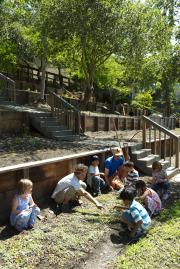The Benefits of Green Schools: The Triple Bottom Line
In two recent talks at the NAIS Green Town Hall in February and at the California Independent Schools Business Officers Association meeting in May, I made the case that greening schools makes sense/cents. It is increasingly clear that environmentally sustainable, high efficiency, high performance green schools offer a compelling “triple bottom line” that promises to save money, strengthen achievement, and improve health. Many of NAIS member schools and public schools across the country are demonstrating tangible results from the green efforts. This article tells some of their stories of success saving significant dollars and highlights these schools: Punahou School; Hawaii Preparatory Academy; Athenian School; Castilleja School; Cate School; Midland School; St. Gregory College Prep; Berkshire School; North Country School; Hotchkiss School; Riverdale School; Lawrenceville School. See the PowerPoint on Triple Bottom Line on the Experience section of the website.
In the past several decades, through the encouragement of the United Nations and other organizations, the term “triple bottom line” has emerged as a way to describe sustainable development. The focus on “people, profit, and planet” suggests that all activity should take into account its human or social impact, economic benefit, and consequences for the environment.[1] While I am convinced personally by the scientific evidence that our planet faces grave danger, and that sustainable schools can help address key policy questions, green schools can be embraced regardless of politics or ideology. The best practices associated with green schools, and highlighted in this article, simply describe good, high quality educational environments.
Perhaps most importantly in these tight economic times, green schools can save money. According to the National Wildlife Federation’s Eco-Schools Program, the nation’s schools spend more than $8 billion a year on energy, and as much as 30 percent of that energy is used either inefficiently or unnecessarily. “By being conscious of energy usage and taking advantage of energy efficient technologies,” they argue, “schools have the potential to significantly cut their electricity use, save money and reduce their burden on the environment.”[2] Who could oppose saving money through energy efficiency and a vigorous embrace of renewable energy? These savings can then be allocated to meet more pressing educational needs.
A decade ago Gregory Kats and a team of experts sponsored by the California Sustainable Building Task Force and the U.S. Green Building Council argued in “The Costs and Financial Benefits of Green Buildings that “sustainable building is a cost effective- investment” and that the “findings should encourage communities across the country to ‘build green’.”[3] They observe: “Integrating ‘sustainable’ or ‘green’ building practices into the construction of state buildings is a solid financial investment…and that a minimal upfront investment of about two percent of construction costs typically yields life cycle savings of over ten times the initial investment.” “The benefits of building green,” they argue, “include cost savings from reduced energy, water, and waste; lower operations and maintenance costs; and enhanced occupant productivity and health.” The Kats report has led to powerful change in California schools where the State Architect launched a 2007 initiative to produce “grid neutral” schools.[4] One public school district in Irvine California, with 39 campuses and 16 that have solar power, for example, saves an estimated $8 M annually; the entire district will likely become grid neutral.
Across the country, private-independent schools have seized the opportunity to save money, through energy efficiency, green buildings, recycling and composting, and on-campus gardens. The stories that follow can be explored in greater depth in Greening America’s Schools (NAIS 2012) and my blog (invernessassociates.org). If you have a story to tell, please email me at pchapman5@gmail.com.
Green School Case Studies
In Hawaii the Punahou School has over the last decade built two LEED certified school complexes and they estimate that “the projected costs savings in energy, water, mechanical and electrical systems will recoup the premium paid for LEED more than six to ten times over a standard 50 year life cycle for these buildings.” At Hawaii Preparatory Academy, their new Energy Lab’s efficient operation will payback the premium for LEED in a few years and pave the way for a campus-wide energy plan that could save up to $500,000 on their annual energy bill.
On the West Coast, the Athenian School in California installed a 1300 panel solar array with a Power Purchase Agreement (PPA)--a contract with another party to finance, design and construct the facility that eliminates the need for the school to pay the upfront costs of installation--and estimates that it produces 60% of the school’s electricity needs; further the school has established baseline measures and aggressively driven costs down in natural gas, water and trash off-haul through recycling and composting. Castilleja School in Palo Alto installed artificial turf in a central courtyard to save $10,000 a year. Cate School has pursued a comprehensive program of energy efficiency, retrofits, and green buildings; they believe that “we are finding the payback period for much of the retrofitting is hitting our bottom line in a very positive manner. We can measure the decrease in electric, water and gas usage for the school as a whole, we can track the solar panels on many of our homes producing more than the homes are using, and we can see that the investment made in the systems and processes improve the health and wellbeing in our constituency as well.” Midland School’s eight-acre organic garden “produces a rich bounty of fruits and vegetables...tended by faculty and students; a cost accounting of the fall season shows that the value of the produce, had we purchased it, would have cost $14K.” In Tucson, Arizona at St. Gregory College Prep, CFO Rick Belding installed a 140 kW solar system and commented: “My perspective was that of a consumer--no cash in the game and a guaranteed 9.5 cents per kWh for 20 years, which meant an immediate savings of about 4 cents/kWh from what we pay the local utility with the added benefit of taking the production of well over 275,000 kWh of electricity off the grid. In many ways a no-brainer.” The school projects saving about $12,000 a year at current rates.
On the East Coast, Berkshire School in Massachusetts installed in December 2011 a Power Purchase Agreement (PPA)–supported eight-acre solar array that is estimated to produce 40% of the school’s electricity needs and to save $1.6 million over the next ten years; these savings come on top of an estimated $900,000 that has been saved since 2005 through conservation efforts spurred by the school’s Climate Action Plan. Hotchkiss School is building a new $14 M biomass central heating facility that will save an estimated $700,000 a year. Josh Hahn, appointed as the school’s Assistant Head/Director of Environmental Initiatives in 2009, reports that Hotchkiss has achieved significant savings through the Environmental Master Plan and Energy Policy, a three-pronged approach to energy management utilizing “aggressive conservation measures, generating energy on site through the use of renewables, and offsetting carbon emissions in ways directly connected to students’ everyday lives and course work.” The North Country School’s biomass plant was installed with strong federal stimulus support at a total cost of $328,550 and could save the school $1.5 million over the life of the equipment, depending on the price of fuel and degree which they source the wood chips locally. The Putney School in Vermont completed a LEED Platinum Field House in 2008 that is the first zero net energy high school in the United States, they used “life cycle analysis” to evaluate the increased upfront capital costs against long-term projected operating savings were compelled to build green. New York City’s Riverdale Country School says that it was able to cut electricity costs by 25% in two year by launching an efficiency campaign and is developing a 25-year energy plan to transition from “dirty No. 2 Fuel Oil to low-cost/low-carbon natural gas.” And Lawrenceville School in New Jersey built a six-megawatt, 30-acre PPA-supported solar system in 2011, one of the largest solar arrays at an educational institution; it promises to provide about 90% of the school’s electricity and save the school an average of $400,000 a year over 20 years.[5]
The triple bottom line for green schools makes sense/cents. By becoming “healthier, wealthier, and wiser,” environmentally sustainable schools offer a reform model that is good for students and for the planet.
[1] “Triple Bottom Line,” The Economist, November 17, 2009
[2] Eco-Schools, “How Can Eco-Schools USA Benefit Your School?” http://www.nwf.org/~/media/PDFs/Eco-schools/5-12-10FinancialBenefits.ashx
[3] Kats, Gregory, 2003. “The Costs and Financial Benefits of Green Buildings,” pp. ii, v, ix. http://www.usgbc.org/Docs/News/News477.pdf; “Greening America’s Schools: Costs and Benefits.” A Capital E Report., http://www.leed.us/ShowFile.aspx?DocumentID=2908
[4] David Thorman and Theresa Townsend, “Grid Neutral Schools, Presentation at the Green California Schools Summit, December 2010.
[5] My thanks to the following individuals for sharing their school’s cost savings information and strategies: Punahou School, Randy Overton, Facilities Director; Hawaii Preparatory Academy, Bill Wiecking, HPA Energy Lab Director; Athenian School, Bob Oxenburgh, CFO; Castilleja School, Steve Taffee, Strategic Projects Director; Cate School, Sandi Pierce, Business Manager; Midland School, Lise Goddard, Director of Environmental Programs; Berkshire School, Frank Barros, Sustainability Director; North Country School, John Culpepper, Director of Facilities and Sustainability; Hotchkiss School, Josh Hahn; Riverdale School, David Patnaude, Director of Plant and Sustainability; Lawrenceville School, Liz Duffy, Headmaster.









